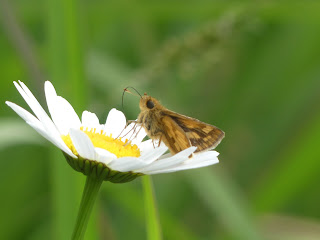Periodical Cicada
They're back! Here's a periodical cicada I met last week at the Sourland Mountain Preserve in Hillsborough. These red-eyed bugs (and they are true bugs) have been living underground for 17 years, giving them one of the most interesting lifecycles around. Don't call them locusts though, since that term refers to grasshoppers, a very different kind of insect.
Though we and other parts of the world have annual cicadas, the periodicals are a North American exclusive; nobody else has cicadas with the 17 year and 13 year lifecycles of the periodical cicadas.
The periodical cicadas emerge in broods that generally occur every 13 or 17 years with the intention of flooding an area with so many cicadas that even if many get eaten by predators, there will still be ample cicadas around to breed and thus continue the species. And while their predators will probably thrive in the year the cicadas emerge, their predator numbers will presumably have returned to normal by the next time these cicadas emerge.
Periodical cicadas and mathematicians have something in common: an interest in prime numbers. Prime numbers are important to cicadas, though it's not clear why. Perhaps it's to prevent predators' life cycles from easily mimicking the cicadas' life cycles. Or maybe it's an attempt to prevent different broods from emerging at the same time, interbreeding, and diluting their lifecycles. For example, my area has Brood X cicadas emerging this year but also has Brood II cicadas set to emerge in 2030. These two broods should only meet up once every 221 (13 x 17) years. (My guess is that both these explanations factor into the prime number lifecycles of the cicadas.)
 |
| May 27, 2021 at the Sourland Mountain Preserve Photo 133213333, (c) jpviolette, some rights reserved (CC BY-NC) |



Comments
Post a Comment